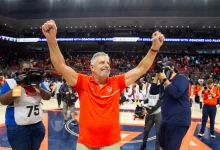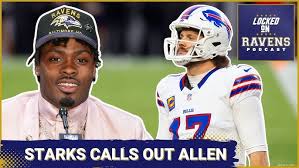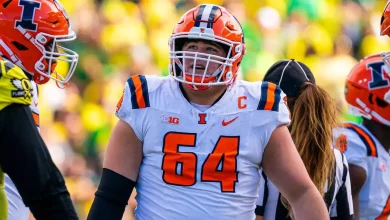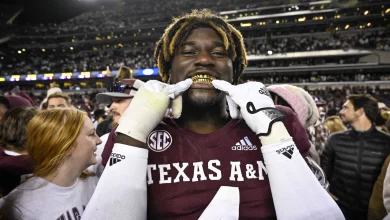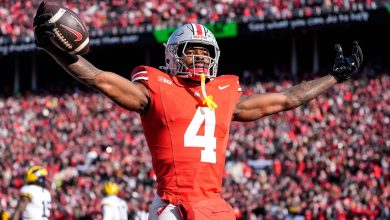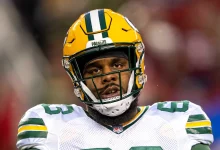Mitch Kupchak baits Hakeem Olajuwon into a scuffle during 1986 West Finals, as referee Jess Kersey intervenes in Game 5.

Game 5 of the 1986 Western Conference Finals between the Los Angeles Lakers and the Houston Rockets was more than just a high-stakes battle between two of the NBA’s elite teams. It was a turning point in a clash of eras, marked not only by brilliant play on the court, but by a moment of tension that saw veteran Lakers forward Mitch Kupchak bait the young, rising superstar Hakeem Olajuwon into a scuffle—one that would leave a lasting imprint on that postseason.
The altercation occurred in a tightly contested game at The Forum in Inglewood, California, a building long known for its intense playoff atmosphere. As the Rockets looked to close out the series and dethrone a Lakers team led by Magic Johnson and Kareem Abdul-Jabbar, tensions reached a boiling point—and the spark came from a strategic, emotional, and controversial confrontation.
Setting the Stage: A Series of Contrasts
The 1986 Western Conference Finals was a classic “old guard vs. new blood” matchup.
The Lakers, winners of two championships in the previous four seasons, were the embodiment of Showtime—fast breaks, finesse, and a cast of veterans who understood how to win on the biggest stage. Led by Magic Johnson, Kareem Abdul-Jabbar, and James Worthy, they were expected by many to cruise through the West.
The Rockets, however, were not your average upstart. Featuring the Twin Towers—7’4″ Ralph Sampson and 7’0″ Hakeem Olajuwon, a second-year phenom from the University of Houston—they had the size, athleticism, and swagger to challenge anyone.
By the time Game 5 rolled around, the series stood 3-1 in Houston’s favor. The Rockets had taken control, stunning the league with their composure and confidence. But the Lakers weren’t going down without a fight—figuratively and, for a moment, literally.
The Scuffle: Kupchak’s Mind Games and Olajuwon’s Reaction
With emotions running high, Mitch Kupchak, a gritty forward known more for his toughness than his statistics, found himself matched up with the young Olajuwon on a box-out under the rim.
Kupchak, then in the twilight of his career, was often inserted into games for physical presence and veteran savvy. He was a role player, but an effective agitator. And in this moment, he did exactly what the Lakers needed: he got under Olajuwon’s skin.
Accounts from those who witnessed it up close describe Kupchak delivering subtle elbows and shoves—tactical physicality, the kind that doesn’t always draw a whistle, but definitely draws a response.
Olajuwon, already frustrated with a series of no-calls and the physical play from L.A., finally reacted. As Kupchak bumped into him yet again, Hakeem threw an elbow that connected.
Referee Jess Kersey immediately stepped in to separate the two, as players and coaches swarmed the court to restore order. The crowd erupted, both in excitement and shock.
The result? Olajuwon was ejected from the game, and the narrative of the series shifted dramatically—if only for a moment.
Strategy or Shenanigans? Kupchak’s Role Examined
To some, Kupchak’s antics were the height of gamesmanship—a veteran using his experience to rattle a less-seasoned opponent. To others, it bordered on provocation, designed to test the limits of physical play and mental toughness.
Kupchak didn’t light up the scoreboard that night—he never did, really—but his actions had a direct impact on the game. With Olajuwon out, the Lakers managed to stay competitive, although they would ultimately fall short, losing the game and the series.
Looking back, many see Kupchak’s move as emblematic of the Lakers’ desperation in the face of a changing Western Conference landscape. It wasn’t dirty—it was strategic, but risky. And for a moment, it worked.
Olajuwon’s Ejection: A Rare Moment of Fire
For a player as composed and fundamentally sound as Hakeem Olajuwon, the incident was a rare flash of temper. Throughout his Hall of Fame career, Olajuwon was known for his elegant footwork, his unshakable focus, and his humility.
But in 1986, he was still learning. Still developing the emotional maturity that would later define his championship runs in the mid-’90s. This ejection was a lesson—one he took seriously.
After the game, Olajuwon expressed regret over letting his emotions take over, but also frustration with the physicality he felt was not being called consistently. His passion was evident, but so was his growing awareness of how to channel it.
Years later, Olajuwon would become one of the calmest, most disciplined leaders in the NBA. But this moment? It was part of that evolution.
Jess Kersey’s Presence and Poise
Amid the chaos, referee Jess Kersey played an essential role. A respected official with decades of experience, Kersey was often called upon to manage high-pressure games—and this one was no different.
His quick action to separate Kupchak and Olajuwon may have prevented the incident from escalating into a full-blown brawl. His authority and respect among players allowed him to calm the situation, assess the penalties, and keep the game moving.
Kersey’s decision to eject Olajuwon, while controversial to some, was consistent with the league’s approach to retaliatory violence. Kupchak avoided punishment, largely because his actions were subtle and non-retaliatory.
The Aftermath: Rockets Advance, Lakers Reflect
The Rockets went on to win Game 5 and the series, advancing to the NBA Finals for the first time since moving to Houston. Though they would fall to the Boston Celtics in six games, the 1986 Rockets established themselves as a force in the league.
For the Lakers, the loss was sobering. Despite the efforts of their core and the momentary spark from Kupchak’s confrontation, they couldn’t keep up with Houston’s size and energy. But the seeds of their comeback were already planted—by 1987, they’d return to the top of the NBA mountain.
Kupchak retired shortly after, transitioning into an executive role with the Lakers where he’d help build multiple championship rosters in the 2000s. Olajuwon, meanwhile, went on to win two NBA championships, two Finals MVPs, and a league MVP, cementing his legacy as one of the greatest centers of all time.
Legacy of the Moment
In the grand scheme of NBA history, the Kupchak-Olajuwon scuffle was a blip. But in the context of that series—and of that era—it was a symbolic moment.
It represented:
- The clash between the old guard and the new generation
- The emotional intensity of playoff basketball
- The fine line between strategy and provocation
It also marked a rare moment where Olajuwon’s poise cracked, revealing the pressure and fire beneath the surface. That fire would later fuel his greatness, but in 1986, it cost him a moment—and perhaps added fuel to the Lakers’ temporary fire.
More Than a Fight
The 1986 Western Conference Finals had its share of iconic performances, but it also had its moments of human drama. The Kupchak-Olajuwon incident in Game 5 wasn’t just about a fight—it was about psychology, playoff tension, and two players representing different stages of their careers.
Mitch Kupchak’s actions, intentional or instinctual, shifted the emotional energy of the game. Hakeem Olajuwon’s reaction, though costly in the short term, became a valuable chapter in his development.
And as referee Jess Kersey stood between two towering competitors, he reminded everyone of the delicate balance between intensity and chaos—something that, in the playoffs, is always just one elbow away.
Would you like this turned into a podcast script, infographic, or social post breakdown?


